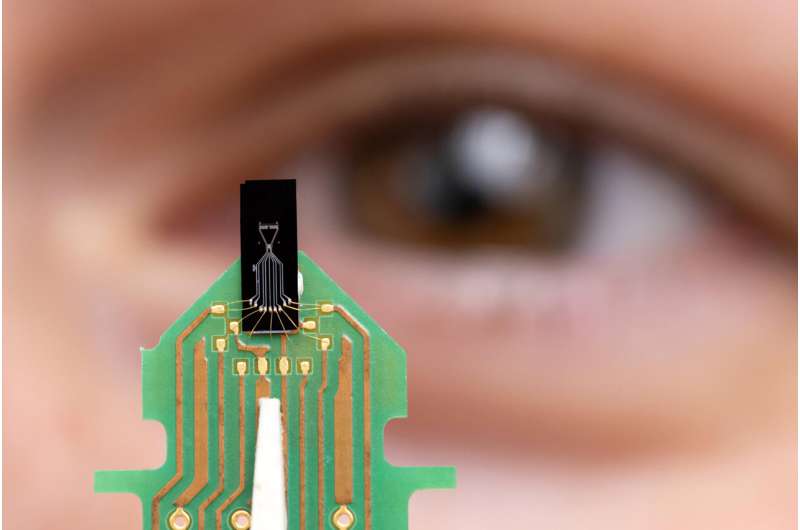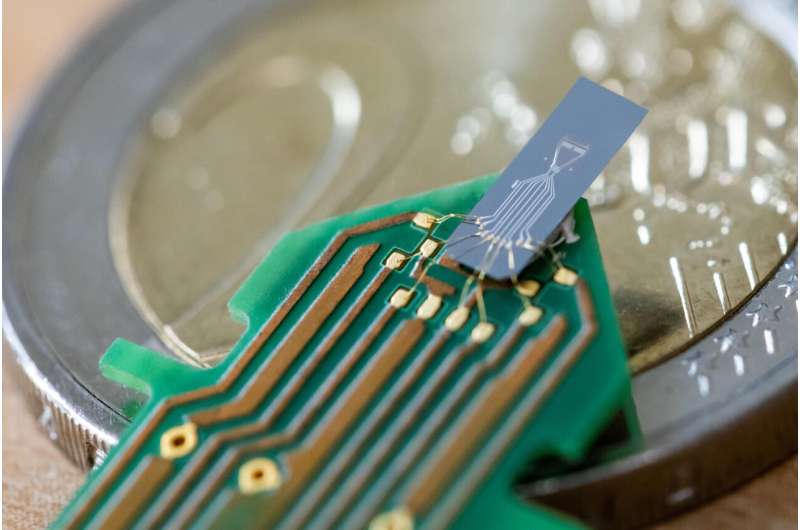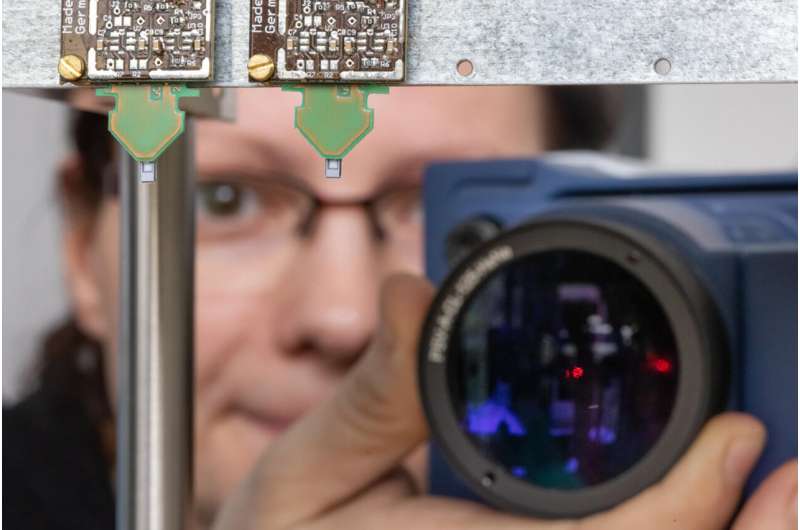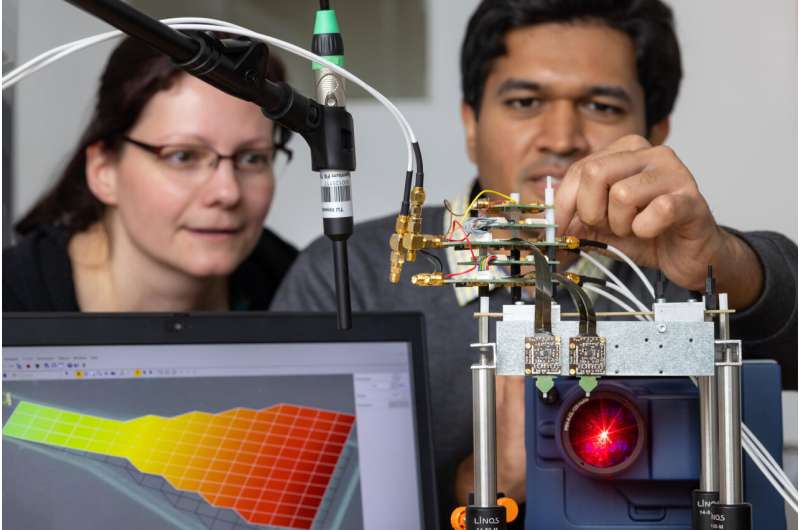May 30, 2023 feature
This article has been reviewed according to Science X's editorial process and policies. Editors have highlighted the following attributes while ensuring the content's credibility:
fact-checked
peer-reviewed publication
trusted source
proofread
An adaptive artificial cochlea that could enhance the performance of hearing aids

In recent years, electronics engineers have developed a wide range of systems inspired by human and animal biology. By closely replicating complex biological processes, these systems could ultimately tackle numerous real-world problems more reliably and effectively.
Researchers at Technische Universität Ilmenau, Kiel University, University College Cork, Karlsruher Institute of Technology and Fraunhofer Institute for Digital Media Technology Ilmenau recently created a new microelectromechanical sensor inspired by the cochlea, the spiral-shaped cavity in the human inner ear that produces nerve impulses in response to sounds vibrations. This artificial cochlea, introduced in Nature Electronics, can process sounds and detect individual signals in noisy environments more effectively than simple microphones.
"The idea for the research was to build artificial hair cells, similar to the hair cells in the inner ear, which are responsible for the sound detection in the human ear," Claudia Lenk, lead author of the paper, told Tech Xplore. "We were inspired by the previous work by Bryan Joyce et al, who used cantilevers with complex feedback to achieve the specific properties of the hair cells. We thought that we can create artificial hair cells quite easily and efficiently, since we have a specific type of cantilevers (silicon beams) which can be read-out and actuated completely electronically."
The human ear and the ears of other mammals work very differently than conventional microphones. As microphones detect all tones (i.e., frequencies) of a sound signal simultaneously, the loud tones they pick up can sometimes mask quieter tones. Ears, on the other hand, contain different hair cells that are responsible for detecting distinct tones (i.e., sound signals in different frequency bands).

"Hair cells in the ears can be individually tuned, in particular the gain for detection, and thus how each tone is detected can be adjusted," Lenk explained. "This is important, if we want to separate, e.g., speech from background signal. In this case, the gain would be high for the tones belonging to the speech signal and low for the background signals. In this way, background and speech can be much easier be separated."
The microelectromechanical cochlea created by Lenk and her colleagues has two key components. The first includes a series of small silicon cantilever designed to act as artificial hair cells, detecting sound signals originating from the surrounding environment. The second is a feedback loop that tunes the detection properties of each cantilever individually.
"The cantilevers oscillate if sound is impinging, and this oscillation is measured by an integrated readout system as an electronic signal," Lenk said. "Each cantilever also contains an actuator. If we apply a voltage at the actuator, it forces the cantilever to bend or oscillate, depending on the applied signal. For the feedback loop: the measured signal is amplified, and an offset (static) voltage is added. The actuator of the cantilever is driven by this signal."
The feedback signal produced by the artificial cochlea's feedback loop ultimately changes how sound is detected by individual cantilever, for instance modulating its gain, sensitivity and bandwidth. The gain of the cantilever can also be tuned to be nonlinear, which means that it will change based on the amplitude of the sounds it picks up. This means that quieter sounds can be amplified, and louder sounds dampened, ensuring that all recorded sounds are detectable by a human listener.

"Since each cantilever reacts only to a certain frequency range of the sound, an array of cantilevers can be used to decompose the signal into the responses for different frequencies, similar to how it is done in the human ear," Lenk said. "Moreover, the detection properties of each cantilever can be individually tuned, thus we can change how different tones are sensed. All properties together, tone specific response, nonlinear response and tuning of the response by feedback, make the system highly adaptable."
The high adaptability of the microelectromechanical cochlea introduced by Lenk and her colleagues could be extremely advantageous for real-world applications, as different environments (e.g., a quiet room, a train station, a mall, etc.) can have varying amounts of background noise. By modulating the sound sensing properties of the cantilevers, their system could be able to pick up far more sounds than conventional microphones, which have fixed properties.
When microphones record sounds in their surroundings, their recordings need to be analyzed in depth using specialized software to detect some of the quieter signals, particularly if the sounds were recorded in crowded and noisy environments. The adaptive cochlea created by the researchers, on the other hand, can apply changes and filter out sounds at an earlier stage (i.e., while it is recording signals). This can simplify several real-world applications, including speech recognition, improving the ability of these systems to classify sounds collected in noisy environments.
"We successfully implemented the properties of human hearing directly in the sensor via a quite simple and fast feedback loop," Lenk said. "This has two big implications. Firstly, the system is rapidly adaptable, and this is quite important for application in various situations. The cochlea's bio-inspired properties also help to highlight important information like when a sound started or specific tones, which should help to make the processing (e.g., speech detection) faster and more efficient (i.e., smaller neural networks necessary for processing)."

Another advantage of the team's artificial cochlea is that it is easy to adapt and integrate into a broader system. For instance, it could be used to develop better performing hearing aids, smart speakers, security systems, and so on.
"Other approaches to build such bio-inspired properties are more complex," Lenk explained. "This makes them harder to scale to the complete hearing range for usage in devices like hearing aids, smart speakers, etc., and they typically do not support adaptation."
Hearing loss is typically caused by a loss of hair cells within the inner ear, which in turn limits the ability to hear specific sounds. As the new artificial cochlea introduced by Lenk and her colleagues replicates the function of hair cells, the team is currently assessing its potential for creating better performing hearing aids.
"Our next steps will be to build a system that covers the whole hearing range, and to combine the MEMS cochlea with neural networks for processing," Lenk added. "The latter is important to enable automatic adaptation and emphasize important sounds, like speech. This system will be developed for the use in hearing aids in our new project NeuroSensEar."
More information: Claudia Lenk et al, Neuromorphic acoustic sensing using an adaptive microelectromechanical cochlea with integrated feedback, Nature Electronics (2023). DOI: 10.1038/s41928-023-00957-5
© 2023 Science X Network

















